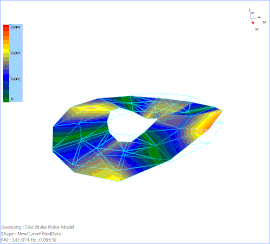Executing the modal analysis of a structure is crucial in order to analyze the modal parameters of a test object. The natural frequencies, damping and mode shapes of the unit under test provides help to adjust the mechanical properties of a structure by optimizing the design and improving the structural behavior of the test unit. Consequently, modal analysis is a critical part of product development.
Read MoreWatch the new Spider-80Ti video produced by Aakash Umesh Mange, Application Engineer at Crystal Instruments. Narration is provided by Walter Kemphaus, Application Engineer at Crystal Instruments.
The Spider-80Ti is a front-end from the Spider-80Xi hardware platform that enables temperature measurement. Spider-80Ti supports temperature measurements from Thermocouples and RTD (Resistance Temperature Detector) sensors.
Read MoreCan the test setup have an effect on the measured modal data?
Do the setup boundary conditions and accelerometers have an effect?
Most definitely!!!!! Let's discuss this.
Read MoreA manufacturer of laptop fans was suffering from the results of slow production testing. The testing capacity was limited by testing products with manually operating instruments in a quiet room. Crystal Instruments provided the easy-to-use Spider hardware and EDM software package as a solution to significantly improve their production testing.
Read MoreA typical vibration test often requires running the test up to 2000 Hz or beyond. This is a tremendous challenge because the resonant and anti-resonant frequencies are often only a few hundred Hz. This article analyzes the obstacles to running a sine test over a high frequency range, including the dynamic characteristics of the Unit Under Test (UUT) and fixtures, the control dynamic range of the vibration controllers, and the sensor mounting locations. Several strategies and recommendations are then discussed with results.
Read MoreThe common-mode rejection ratio (CMRR) specification defines how well a differential amplifier rejects common-mode signals. A common-mode signal is the same (common) to both conductors in a typical two conductor connection (signal conductor and ground conductor).
Read MoreIf we perform a roving impact hammer test and impact many points, is there any possibility of missing a mode? Well… you need to be careful where you place the accelerometer.
Read MoreStructural measurements on infrastructure are growing in demand given the aging buildings, bridges, and dams that populate countries around the world. Structural measurements are not the only measurements needed for aging infrastructure, but they do play a role. In the structural measurement category, Crystal Instruments offers products to measure and analyze data for large structure measurements like the measurements done on the Vieux Emosson Gravity Dam.
Read MoreIn any multi-channel DAQ or vibration control system, where each channel is capable of measuring unique sensors, it is necessary to quantify how the channels are different from each other. The channels are designed identically, but component tolerances will cause differences between channels.
Read MoreOn January 17, 2021, Virgin Orbit successfully reached orbit with LauncherOne and deployed 10 CubeSats into Low Earth Orbit for NASA. Prior to the launch, the engineers at Virgin Orbit performed extensive vibration testing using Crystal Instruments vibration controllers with hundreds of channels. A Virgin Orbit dynamics engineer confirmed that “the Spider controllers played an important role in our successful launch,”
Read MoreFounded in 1996, Crystal Instruments designs and manufactures instrumentation products for machine vibration monitoring, dynamic measurement, and environmental testing. The products are developed in Silicon Valley and our modern lab in North Carolina. Crystal Instruments products are thoroughly tested on a variety of vibration shakers and environmental chambers in our lab during the design phase to meet the extreme requirements of military and aerospace applications.
Read MoreWhich shaker excitation is best? Is there any difference? Well ... that's a good question. Let's talk about the different techniques.
Let's discuss the most commonly used excitation techniques for modal analysis today. These are random, burst random, sine chirp and digital stepped sine. But before we discuss the excitation techniques themselves, there are a few basics that we need to discuss first. Let's try to categorize the different techniques and explain when to use which technique. First of all, let's break up the excitations into deterministic and non-deterministic (or random) excitations.
Read MoreWatch Aakash Umesh Mange’s new video featuring the powerful Spider-80SG data acquisition system combined with the versatile EDM DSA software. This simple and efficient package for strain gage measurements can include the Spider-80Xi chassis, which scales up to 512 channels. Contact our team to schedule a demo or to learn more.
Read MoreThere are two steps for converting an analog signal into a digital signal – quantization in time (sampling) and quantization of amplitude. Any signal that goes through the sampling process is subject to the effect of aliasing. The common use of the word ‘alias’ is used to describe a false name or identity, which is similar to how the term is used in signal processing.
Read MoreWatch Darren Fraser’s Multi-resolution Overview presentation from this year’s ESTECH 2021 conference. Viewers will receive a brief review followed by several practical application examples. The Multi-Resolution function is patented by Crystal Instruments.
Read More














